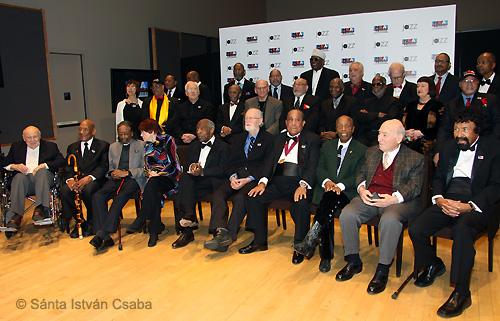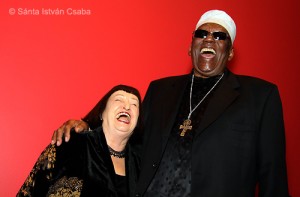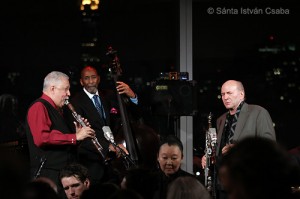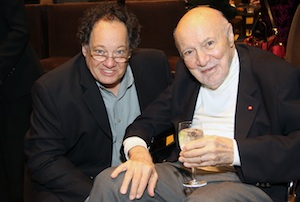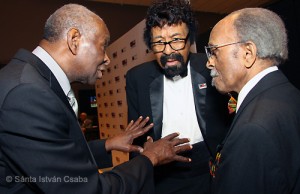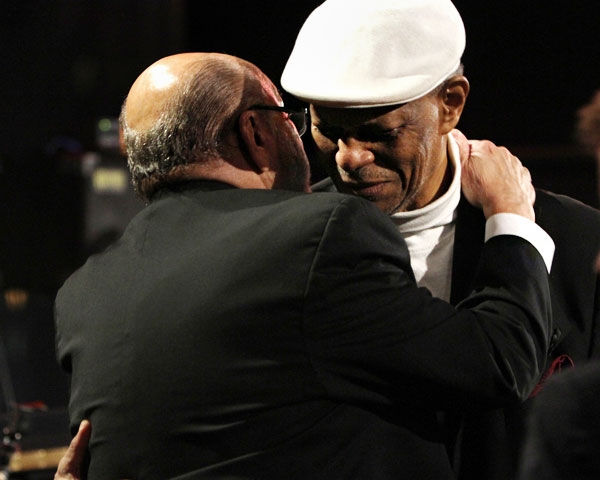There is no Golden Globes, Emmies, Oscars or highly hyped Grammys for jazz. So the National Endowment of the Arts’ Jazz Masters award is, as acting NEA chair Joan Shigekawa said at ceremonies crowning its 2013 inductees on Jan. 14, “the greatest honor the nation can bestow” on veteran creators of America’s world-beloved vernacular yet “classical” music. You’d think there’d be a lot of media brouhaha, generating publicity that gets jazz high in the day’s trending topics, especially with past Masters and the new ones all together for a night of music at Dizzy’s Club in Jazz at Lincoln Center, one of the most glamorous venues in the U.S. of A. See it now: the live-streamed six-camera shoot is now archived on the NEA’s website www.Arts.Gov.
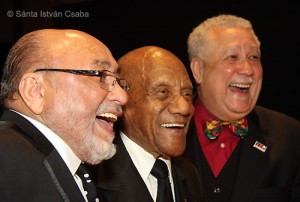
Mt. Rushmore of Latin Jazz Masters: from left, Eddie Palmieri, Candido Camero, Paquito d’Rivera;
photo by Sánta István Csaba
But no. Despite the presence of musical artists — artists! — Roy Haynes, Muhal Richard Abrams, Lee Konitz, Sheila Jordan, Dave Liebman, Paquito d’Rivera, Candido Camero, Jimmy Heath, Annie Ross, Randy Weston, McCoy Tyner, Ahmad Jamal, Joe Wilder, Jimmy Owens, Chico Hamilton, David Baker, Ron Carter, Jimmy Cobb, Kenny Baron, Wynton, Branford and Jason Marsalis all in one room! Along with their newly invested peers Eddie Palmieri, Lou Donaldson and Mose Allison! In what centuries hence might be considered the historic occasion upon which several of them played together! — the sum total of coverage three days after the event comprises exemplary accounts by Nate Chinen in the New York Times and Larry Blumenfeld on his blog at ArtInfo, tweets mostly generated by the NEA itself, NPRMusic (which collaborated in live broadcast with WBGO and Sirius XM broadcast it, too) and others involved in the production, very little notice on Facebook, and a post by the NEA’s own blogger Rebecca Gross that’s already been superseded by a lengthy “postcard” from newly retired NEA chair Rocco Landesman. Oh yes, the issue was raised by Peter Hum in the Ottawa Citizen and Anna Silman in The New York Observer that newly named Jazz Master “advocate” Lorraine Gordon of the Village Vanguard, who couldn’t attend due to illness, has not endorsed the “Jazz for Justice” initiative of Local 802 of the American Federation of Musicians to gain pension contributions for musicians who gig in New York’s clubs.
There was a photo op, at which freelancers including SÃ¥nta István Csaba, the Transylvanian cum Budapest photographer who’s supplied images to JBJ all week, first captured a formal portrait and then were free to grab candids. No story in the Wall Street Journal (though Blumenfeld, a frequent freelancer for it, said he had pitched the Masters hard), nothing up yet on the websites of JazzTimes or DownBeat (though representatives of both jazz mags attended the black-tie investiture dinner) nor on JazzCorner or AllAboutJazz, nothing noted in network or cable tv news, no notice in mainstream periodicals . .
What can the NEA — or anyone — do to gain attention to the Jazz Masters, and maybe more for jazz? How about:
- making the event even more public and media-friendly,
- doing something to show jazz is relevant to young audiences and so are jazz’s elders, and
- collaborating with commercial producers who know how to put on a really big show, promoted where people go to get their information now?
Let’s face it, JBJ readers: the 2013 NEA Jazz Masters may be revered by us fans, but they’re not exactly household names throughout greater America. Mose Allison’s a genuine hipster from the ’60s, slowed at age 85, performing intermittently, though his most recent new album The Way of the World (2010) was produced by rootsy-folkie pop-rocker Joe Henry, and has been favorably reviewed. Palmieri is quite active at  76, in December playing a dazzling if incomplete “Career Retrospective” concert  at JALC with Latin jazz and dance ensembles. Donaldson, 85, tours constantly with his guitar-organ-drums combo, deploying the salt and vinegar tone and confident swagger he’s perfected over 60 years. Although there was some very fine music performed during the Jazz Masters ceremonies — an especially hot rendition of Miles Davis’ “All Blues” by Liebman on soprano sax, d’Rivera on clarinet, Carter, Barron and Cobb (who recorded the original in 1959) — most of the performances were most appreciable by listeners steeped in the finer points of jazz tradition, but not so much by those who would be moved by its gregarious edge.
This year’s Awards presentations, which Landesman directed in 2011 would not occur at all but was reinstated in July of that year at the express command of the Congressional budget committee, suffered some austerity cuts. Rather than the large scale affair held in JALC’s Rose Hall, an 1100 seat theater to which tickets were given free on a first come/first served basis to whoever requested them, this year the site was Dizzy’s with 100 some seats to accommodate living Jazz Masters, their guests, some JALC figures and very few invited others. Regular folks were urged to hold Jazz Masters parties in locations of their choice — one such was in D.C. at Twin’s, presented by Capital Bop; no specifics on others.
At Lincoln Center, most of the press was ensconced in a side room to watch the live stream of the ceremony being held some 30 yards and perhaps six walls away. It was not endearing that no food or beverages were served there but soft drinks. JALC program director Jason Olaine wisely took it on himself to make a wine run, otherwise this scribe and others would have been dryly and disagreeably watching our heroes sit, dine, speechify and perform on a screen, volume down low, out of touch. If the press must be sequestered, what about giving us computers on which we could report the event live on blogs, Facebook or Twitter, or makes the space a newsroom to which we could usher Masters and other significant parties for quickie interviews?
With advances in Skype and similar technology, this room could have hosted an open q&a session with journalists from remote locals after the formal photo session. There were fascinating glimpses of unexpected musicians’ inter-relations there, for instance when Muhal was chatting with Baker and Heath, or Randy Weston stood looming over Sheila Jordan.
Of course, the clever, well-connected and plain lucky jazz journalist will get to the action. I was very pleased to have a few moments with George Avakian, one of the designated Jazz Masters Advocates — as record producer to Louis Armstrong, Duke Ellington, Sonny Rollins and Miles Davis, among others, and the man who invented the reissue, the album of thematically connected songs (when they were being issued on 78 rpm discs) and the liner-note.
As far as the ceremony was concerned, what I most wanted to be upclose for  was the presentation of the Award, acceptance and performance by Eddie Palmieri. So when I realized he was almost due onstage, I ducked from the journalists’ holding pen into a side hall that led into Dizzy’s, and stumbled upon Palmieri himself waiting in the wings his son Eddie the 2nd. Palmieri is one of my personal favorite music-makers, I nominated him in this blog for the Jazz Master award, I’ve written about him for DownBeat and The Wire and produced an NPR feature about him, he knows my name and face — years ago I even took him to hear McCoy Tyner in Chicago’s Modern Jazz Showcase — and he was getting a run-down from his son about what to say when he accepted this honor, what to play solo immediately after.
“Mention Uncle Charlie,” Eddie the 2nd told Eddie the 1st, referring to his older brother who was also a Latin and jazz keyboardist (and who died in 1988). “Talk about McCoy, who’s giving you the Award. You don’t have to say much, or play long.”
The 1st — composer, arranger, bandleader, visionary, luminary Sun of Latin Music — nodded in agreement, but was obviously still nervous, and looked at me worriedly. “I’m not a solo pianist ” he said, “You know that. I think I’ve been set up.”
“No, Eddie,” I told him, “I saw you here at Lincoln Center last month, you played a solo and everybody dug it. Just play your ideas, it’ll be great. I can’t wait to hear it. You’re great at this, everybody is excited to hear you.”
He went out onstage, talked about his brother Charlie, also name checked Tito Rodriguez and Tito Puente, then described at length the first time he heard John Coltrane’s mid ’60s quartet, and how McCoy Tyner changed his life with a fabulous long solo . Then the Sun sat down and threw himself into a glorious, spontaneous rendition of a composition he announced as “Iraida,” named after his wife. It began with curious, dissonant chords, developed into comforting, lyrical passages, broke away for a brief percussive rave, dawdled in time, digressed for a spikey line I know as “Revolt/La Libertad Logico” and ended in triumph. I was sitting nearby, talking with Joanne Robinson Hill, widow of Jazz Master pianist/composer Andrew Hill, when I felt a clap on my shoulder. I turned, there was Eddie:  “You’re pep talk really helped me,” he said.
Most wonderful moment of my career in music journalism? Certainly among the most gratifying. To be even that much of a part of a performance by an NEA Jazz Master. . . That’s why I’d attended the ceremony, and that’s why I think the NEA ought to develop its jazz program so it doesn’t all revolve around this once-a-year celebration of excellence, so its continuous promotion of Jazz Masters and jazz itself gets the audience the Masters and jazz deserve and will reward.

